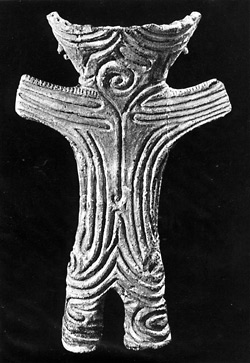Keynotes 3

ca. 5000 BCE millet-based agriculture spread from
[ 2333 BCE founding of the state of Choson according to a traditional myth
of shamanistic origin: the first ruler is said to be the son of the heavenly
king. The son wanted to live among men and with the permission from his father
and 3,000 followers he descended from heaven and ruled over the people. He
taught them agriculture and righteous living in a community.
A bear and a tiger who lived on his territory prayed to the ruler for permission
to become human. The ruler consented but asked them to remain in a cave with
little food for 100 days. While the tiger left the cave because he became
hungry, the bear patiently waited until the 100 days were over. Therefore
the bear was rewarded with the transformation into a woman. The woman prayed
to become a mother and finaly gave birth to a son who became the first human
king, Tan'gun, of Choson, the Land of Morning Freshness.
2000 BCE domestication of pigs, sheep, goats
1100 BCE
beginning of rice cultivation and bronze technology
3rd cent.
BCE iron technology
194 BCE state
of Choson with the capital
128-109 BCE
after 220 CE Korean territory remains politically
independent from
emerge: Koguryo, Paekche, Silla, Kaya (Mimana)

6000 BCE oldest Neolithic culture: Jomon-Culture (Ainu; cord-marked pottery; sunken-pit houses;
hunting, gathering, fishing)


5th cent BCE iron swords, armor, agricultural tools; houses raised to ground level;
improved quality of pottery
ca. 300 BCE Yayoi-culture replaces Jomon culture: potter's wheel; rice cultivation; irrigation; use of
bronze for ceremonial objects; trade with China and Korea; 'provincial
Korean'
ca. 3rd cent CE under Korean influence great tomb mounds for high-standing
person are piled up in tomb building

3rd cent CE The first written records of Japan are historiographical works written in Chinese characters:
Kojiki ‘Record of Ancient Matters’
Nihongi ‘History of Japan’; both records derive the origin of the Japanese
ruler from the sun-goddess Amaterasu
Emperor/empress are conceived as temporal, spiritual rulers who preside
over the worship of Amaterasu and the deities of nature (‘kami’);
the state cult is neither a fully developed religion, nor an organized
philosophy propagating a moral code
late 5th cent CE iron weapons and armor
until 6th
cent CE strong relations
with the southeast coast of
6th cent CE Buddhism transmitted to
until 9th
cent CE immigration from
served as artisans (weavers, metallurgists etc.)
after 618 CE Chinese cultural ideals
–imported to
prominent influence in